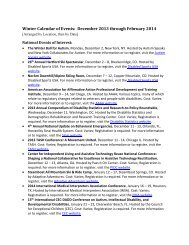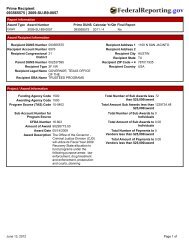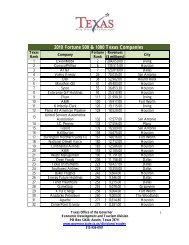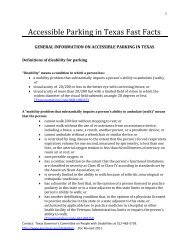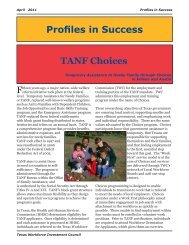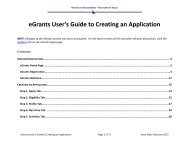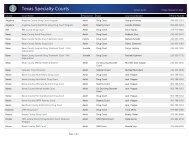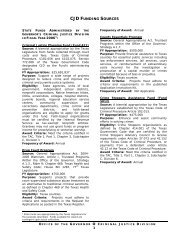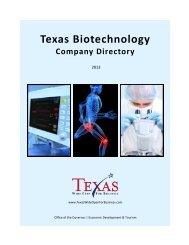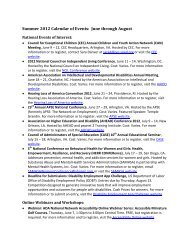People with Disabilities: A Texas Profile
People with Disabilities: A Texas Profile
People with Disabilities: A Texas Profile
Create successful ePaper yourself
Turn your PDF publications into a flip-book with our unique Google optimized e-Paper software.
25.0%<br />
20.0%<br />
15.0%<br />
10.0%<br />
Figure 9: <strong>Texas</strong> Labor Force Participants and Nonparticipants <strong>with</strong> <strong>Disabilities</strong> Receiving SSI by<br />
Disability Type, 2011<br />
5.0%<br />
0.0%<br />
23.7%<br />
8.4%<br />
Independent<br />
living difficulty<br />
21.1% 21.0%<br />
6.3%<br />
Cognitive<br />
difficulty<br />
4.2%<br />
Self‐care<br />
difficulty<br />
17.3%<br />
Table notes: 2011 ACS microdata. Percentages represent the portion of labor force participants <strong>with</strong> each<br />
difficulty who received SSI in 2011. Data excludes individuals reporting $0 SSI.<br />
<strong>Texas</strong> Veterans and <strong>Disabilities</strong><br />
18.5%<br />
3.2% 2.9%<br />
Vision difficulty Ambulatory<br />
difficulty<br />
Not in Labor Force <strong>with</strong> Disibility Labor Force Participant <strong>with</strong> Disability<br />
11.8%<br />
The issue of disabilities is particularly relevant for the veteran population. On average, the veteran<br />
population is older than the nonveteran population and the likelihood of developing a disability<br />
increases <strong>with</strong> age. Additionally, because of the rigors associated <strong>with</strong> military service, numerous<br />
veterans have service‐connected disabilities. A more thorough analysis of the <strong>Texas</strong> veteran population<br />
is available in Veterans in <strong>Texas</strong>: A Demographic Study (<strong>Texas</strong> Workforce Investment Council, 2012).<br />
ACS data indicate that approximately 27 percent of all <strong>Texas</strong> veterans (430,988 individuals) report<br />
having some type of disability compared to 14 percent of the age 18 and older nonveteran population<br />
(2,371,394 individuals). These reported disabilities may not necessarily be the consequence of military<br />
service. Veterans <strong>with</strong> a service‐connected injury or illness incurred or aggravated during active military<br />
service are assessed and assigned a disability rating. Depending on the severity of the disability rating,<br />
veterans may receive disability benefits in the form of monthly compensation. Approximately 19<br />
percent of all <strong>Texas</strong> veterans (309,299 individuals) have a service‐connected disability rating.<br />
Table 18 illustrates the percentage of <strong>Texas</strong> veterans <strong>with</strong>in the different ranges of disability ratings.<br />
Approximately five percent of <strong>Texas</strong> veterans have a zero percent disability rating indicating that the<br />
service‐related injury does not impair the veteran. The majority of veterans <strong>with</strong> a service‐connected<br />
28 <strong>Texas</strong> Workforce Investment Council<br />
1.7%<br />
Hearing<br />
difficulty




